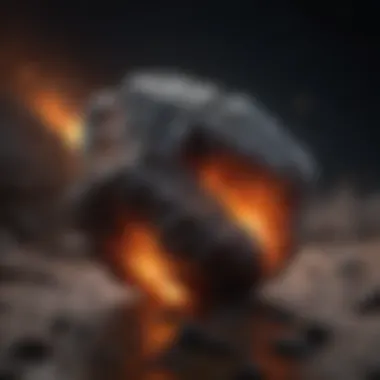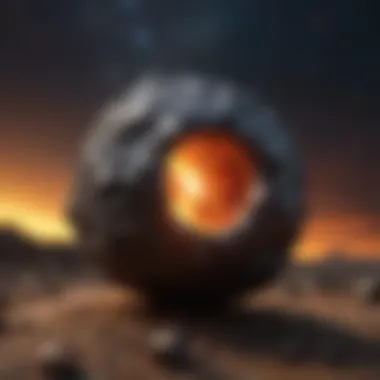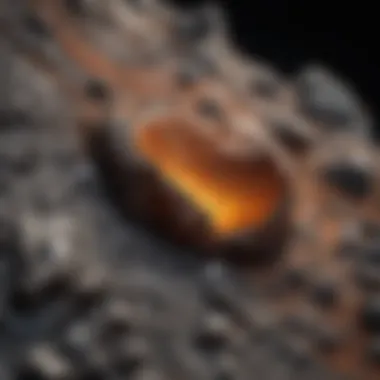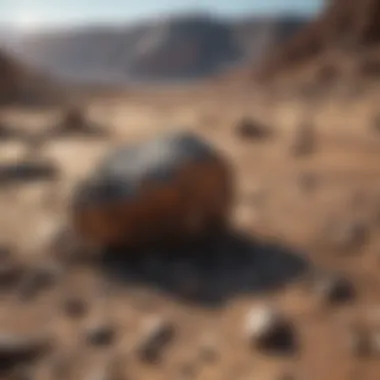Unveiling the Mysteries of Meteorites: A Visual Journey


Rock and Fossil Identification
When venturing into the fascinating realm of meteorites through captivating photography, understanding the types of meteorites is paramount to appreciate their intricate beauty. Meteorites are classified into three main types: stony meteorites, iron meteorites, and stony-iron meteorites. Each type exhibits unique characteristics, ranging from the presence of chondrules in stony meteorites to Widmanstätten patterns in iron meteorites. To identify these meteorites accurately, collectors must pay attention to key characteristics such as fusion crust, regmaglypts, and inclusions that provide essential clues to their extraterrestrial origins. Utilizing tools like magnet sticks, streak plates, and loupes aids collectors in distinguishing between different meteorite types, ensuring an enriching collecting experience fueled by knowledge and precision.
Collecting Tips and Techniques
For avid meteorite collectors seeking to enhance their collection with extraordinary specimens, employing best practices is crucial. Exploring prime collecting sites such as deserts, Antarctica, and strewn fields increases the chances of discovering rare meteorites. When extracting specimens from the ground, collectors should use caution and proper tools to avoid damaging the meteorites. Techniques like metal detecting, grid searching, and visual scanning prove beneficial in locating meteorites effectively. By following safety protocols and ethical guidelines, collectors can responsibly gather a diverse array of meteorites to enrich their collection and deepen their understanding of these celestial gifts.
Preservation and Display
Preserving meteorites for long-term enjoyment involves employing various techniques to prevent deterioration and maintain their intrinsic beauty. Proper storage methods such as using desiccants, individual containers, and protective casings shield meteorites from environmental factors that could compromise their integrity. Creative display ideas like shadow boxes, rotating platforms, and illuminated showcases showcase meteorites as captivating works of art, inviting admiration and sparking conversation among enthusiasts. By implementing effective preservation and display strategies, collectors can ensure their meteorite collection remains intact and visually striking for generations to come.
Geological Insights
Delving into the geological insights offered by meteorites unveils a world of scientific significance and historical intrigue. Meteorites, as remnants of our solar system's formation, offer insights into planetary processes, early Earth conditions, and celestial dynamics. The discovery of rare meteorites like Martian meteorites and lunar meteorites unveils a window into the geological composition of other celestial bodies, enriching our understanding of the cosmos. Notable discoveries, such as impact-induced features and unique mineral compositions, further contribute to the geological significance of meteorites, inspiring awe and wonder among collectors and researchers alike.
Introduction
In the vast expanse of our universe, there exist celestial bodies that intrigue and captivate us—meteorites. This introduction serves as the metaphoric doorway into the enigmatic world of meteorites through the lens of captivating photography. As we embark on this cosmic journey, it is essential to grasp the significance and allure that meteorites hold for both scientists and enthusiasts alike.
Meteorites, remnants of our solar system's formation, offer a tangible connection to the mysteries of our celestial origins. Through the artistry of photography, we can unlock their hidden beauty and unravel the stories engraved in their cosmic tapestry. The intricate patterns, textures, and colors of meteorites reveal a visual language that transcends scientific data, inviting us to explore a world beyond our own.
This section sets the stage for a deep dive into the wonders of meteorites showcased through the lens of talented photographers who have dedicated their craft to capturing these extraterrestrial treasures. By understanding the role of photography as a visual gateway to the cosmos, we pave the way for a profound exploration of these cosmic wanderers that have traversed the vastness of space to finally rest in our hands.
The intersection of art and science in meteorite photography offers a unique perspective on these ancient relics, breathing life into the scientific endeavors that seek to unravel the secrets of our universe. Through the medium of photography, we can not only observe the intricate details of meteorites but also appreciate the convergence of artistic vision and scientific inquiry, making this journey both visually captivating and intellectually stimulating.
Unveiling the Beauty of Meteorites
This section delves into the significance of exploring the beauty of meteorites through captivating photography within the context of this article. Meteorites, with their extraterrestrial origin and diverse characteristics, hold a mysterious allure that has intrigued humanity for centuries. By visually documenting these celestial objects, we not only enhance their asthetic appeal but also gain deeper insights into their composition and formation. Highlighting the key elements of meteorite beauty can offer both collectors and enthusiasts a closer connection to these cosmic remnants.
Photography as a Window to the Cosmos


Photography serves as a powerful tool in unlocking the mysteries of the cosmos by capturing intricate details of meteorites that are otherwise invisible to the naked eye. Through specialized techniques and equipment, photographers can harness the beauty of these extraterrestrial specimens, providing a glimpse into the vast universe beyond our reach. By utilizing photography as a medium, we transcend physical limitations and invite viewers to contemplate the celestial origins of meteorites, fostering a sense of wonder and curiosity about the cosmos.
Capturing the Intricate Patterns and Textures
In this segment, we explore the art of capturing the intricate patterns and textures found in meteorites, showcasing the unique features that make each specimen a work of art. From the delicate crystalline structures to the rugged fusion crusts, photographers aim to highlight the striking details that reveal the dynamic history of these cosmic travelers. By focusing on the textures and patterns present in meteorites, we not only document their physical attributes but also unravel the narratives hidden within their rugged surfaces, offering viewers a glimpse into the complex journey these celestial rocks have undertaken.
Revealing the Diverse Colors of Meteorites
The diverse colors exhibited by meteorites tell a tale of their formation processes and chemical compositions, adding an intriguing dimension to their visual appeal. By revealing the myriad hues present in meteorites - ranging from deep browns and blacks to vibrant greens and reds - photographers can evoke a sense of fascination and awe in their audience. Through the lens of a camera, we can explore the rich palette of colors that adorn these extraterrestrial relics, inviting viewers to appreciate the artistry and complexity of meteorites in a new light.
Understanding Meteorites
In the intricate study of meteorites, understanding their composition and structure is paramount. This section delves into the core of meteoritic science, unraveling the mysteries hidden within these extraterrestrial rocks. By comprehending the composition and structure of meteorites, scientists can glean invaluable insights into the formation and evolution of our solar system. From rare mineral components to unique isotopic signatures, meteorites serve as time capsules from the early days of our cosmic neighborhood.
Composition and Structure of Meteorites
The composition and structure of meteorites offer a fascinating glimpse into the origins of celestial bodies. These specimens are composed of various elements and compounds, ranging from silicates and metals to organic molecules. By analyzing the chemical makeup and internal architecture of meteorites, researchers can infer the conditions prevalent during the birth of our solar system. Furthermore, the crystalline structure and isotopic compositions provide clues about the processes that shaped these enigmatic stones over billions of years.
Classifying Meteorites: Iron, Stony, and Stony-Iron
Meteorites come in diverse forms and compositions, leading to classification into three main groups: iron, stony, and stony-iron meteorites. Iron meteorites predominantly consist of nickel-iron alloys, reflecting their origin from the metallic cores of asteroids. Stony meteorites, on the other hand, comprise silicate minerals like olivine and pyroxene, resembling the rocky mantle of planets. Stony-iron meteorites represent a hybrid mix of metallic and silicate components, showcasing a unique blend of materials not commonly found on Earth. By categorizing meteorites into these distinct groups, scientists can trace their trajectories through space and infer their probable sources within the solar system.
Meteorite Impact on Earth and Scientific Significance
The impact of meteorites on Earth transcends mere geological events; these cosmic visitors bear profound scientific significance. Upon colliding with our planet, meteorites can offer crucial insights into the dynamics and processes governing outer space. By studying the remnants of meteorite impacts, researchers can deduce the energy levels, velocities, and angles at which these celestial objects entered Earth's atmosphere. Additionally, the chemical signatures and isotopic compositions of meteorites deliver vital clues about the formation and differentiation of planetary bodies. Through meticulous analysis and scientific inquiry, meteorite impacts present a unique opportunity to investigate the celestial forces that have shaped our world and the universe at large.
Photographic Techniques for Meteorites
Photographic techniques for meteorites play a crucial role in capturing the essence and allure of these cosmic relics. From highlighting the unique textures to showcasing the diverse colors, mastering the art of photographing meteorites requires precision and creativity. By understanding the technical aspects of lighting, angles, and post-processing, photographers can bring out the best in these celestial gems, providing viewers with unparalleled visual insights.
Lighting and Angles for Enhancing Meteorite Features
When it comes to enhancing meteorite features through photography, lighting and angles are key elements to consider. The way light interacts with the surface of a meteorite can dramatically affect its appearance in a photograph. By experimenting with natural light or artificial lighting setups, photographers can create dynamic images that highlight the textures and patterns of meteorites in vivid detail.


Angles also play a crucial role in capturing the essence of a meteorite. By exploring different perspectives and viewpoints, photographers can showcase the three-dimensional nature of these extraterrestrial specimens. Playing with angles allows for a more immersive visual experience, where viewers can appreciate the intricate details and unique characteristics of each meteorite.
Macro Photography for Close-Up Details
For enthusiasts seeking to delve into the intricate details of meteorites, macro photography offers a window into a miniature world. By using specialized macro lenses, photographers can capture close-up shots that reveal the smallest intricacies of meteorite surfaces. From tiny crystals to subtle cracks, macro photography allows for a level of detail that is not visible to the naked eye.
Macro photography enables viewers to appreciate the fine features of meteorites, showcasing their complexity and beauty at a microscopic level. By zooming in on specific areas, photographers can create stunning visual narratives that invite audiences to explore the unseen wonders of these cosmic artifacts.
Editing and Post-Processing for Stunning Visual Impact
In the realm of meteorite photography, the journey does not end with the click of a shutter. Post-processing plays a vital role in enhancing the visual impact of meteorite images. From adjusting colors to sharpening details, editing software allows photographers to refine their captures and create visually striking compositions.
Editing and post-processing enable photographers to fine-tune the contrast, saturation, and overall aesthetic of meteorite images. By experimenting with different editing techniques, photographers can evoke emotion and curiosity through their visual storytelling, captivating audiences and igniting a sense of wonder for the enigmatic world of meteorites.
Notable Meteorite Photographers and Collections
In this section, we delve into the pivotal role that notable meteorite photographers and collections play in enriching our understanding and appreciation of these cosmic marvels. Not only do they provide us with visually captivating imagery but also serve as custodians of scientific information and historical significance.
Notable meteorite photographers possess a unique ability to showcase the beauty and intricacies of meteorites through their lens, capturing details that might go unnoticed by the untrained eye. Their skill in utilizing lighting, angles, and editing techniques elevates meteorite photography from mere documentation to works of art that mesmerize and educate viewers.
Collections of meteorites curated by enthusiasts and institutions serve as invaluable repositories of rare specimens from across the globe. These collections offer researchers and enthusiasts alike the opportunity to study meteorites up close, enabling insights into their composition, structure, and origins. The documentation and preservation of these meteorite collections contribute significantly to the scientific community's understanding of these extraterrestrial objects.
Profiles of Renowned Meteorite Photographers
In this subsection, we spotlight the achievements and contributions of distinguished meteorite photographers who have made a mark in the field through their exceptional work. From capturing the gleaming textures of iron meteorites to revealing the intricate patterns of stony meteorites, these individuals have set the standard for excellence in meteorite photography.
Renowned meteorite photographers such as [Photographer Name] and [Photographer Name] have garnered international acclaim for their innovative approaches and artistic vision in portraying meteorites. Their portfolios boast a diverse range of meteorite specimens, each image telling a unique story of cosmic origins and terrestrial impact.
Through detailed biographical profiles, we explore the methodologies and inspirations behind these photographers' stunning work, shedding light on the blend of artistry and scientific rigor that defines their contributions to the field of meteorite photography.
Exploring Exceptional Meteorite Collections


This section delves into the extraordinary collections of meteorites assembled by museums, private collectors, and research institutions around the world. These collections house a diverse array of meteorites, ranging from ancient iron meteorites to rare carbonaceous chondrites, offering a comprehensive snapshot of meteoritic diversity.
Exceptional meteorite collections like those found at the [Museum Name] and [Collector's Name] showcase not only the beauty of meteorites but also their cultural and historical significance. These curated assortments enable researchers and enthusiasts to study meteorites from various regions and time periods, broadening our understanding of planetary formation and evolution.
Through insightful narratives and detailed descriptions, we unravel the stories behind these exceptional meteorite collections, highlighting their role in advancing scientific knowledge and inspiring awe and curiosity among audiences worldwide.
Documenting Rare and Unique Meteorite Finds
In this subsection, we delve into the fascinating world of rare and unique meteorite finds that have intrigued researchers and collectors alike. From meteorites containing rare minerals to those with peculiar shapes and structures, these specimens push the boundaries of our knowledge about the cosmos.
Documenting these rare and unique meteorite finds requires meticulous attention to detail and scientific expertise to ensure their significance is accurately captured and preserved. Whether it's a newly discovered Martian meteorite or a fragment from a historic meteor shower, each find contributes valuable insights into the mysteries of our solar system.
By exploring the stories behind these exceptional meteorite finds, we gain a deeper appreciation for the painstaking research and serendipitous discoveries that fuel our fascination with these extraterrestrial remnants.
Impact of Meteorite Photography
In this section, we delve into the pivotal role of meteorite photography within the overarching theme of our exploration into these enigmatic celestial objects. Meteorite photography goes beyond mere documentation; it serves as a visual gateway that ignites curiosity, captures the essence of scientific exploration, and bridges the gap between collectors and researchers. By highlighting the key elements and benefits of meteorite photography, we aim to provide a profound insight into why this visual medium is paramount in enhancing our understanding and appreciation of meteorites.
Inspiring Curiosity and Scientific Exploration
Meteorite photography acts as a catalyst for inspiring curiosity and driving scientific exploration. Through visually compelling images, viewers are drawn into the mysterious allure of meteorites, sparking a sense of wonder and prompting further inquiry. The intricate details and mesmerizing textures captured in photographs fuel the imagination, pushing enthusiasts to delve deeper into the science behind these cosmic relics. By showcasing meteorites in all their splendor, photography plays a crucial role in nurturing a passion for astronomy and encouraging a deeper dive into the realms of planetary science.
Educational Value of Meteorite Images
The educational value of meteorite images cannot be overstated. These visuals serve as invaluable tools for disseminating scientific knowledge, making complex geological concepts accessible to a wide audience. Meteorite photography not only provides a visual feast for the eyes but also acts as a vehicle for education, offering insights into the composition, classification, and impact of meteorites on Earth. Through meticulously crafted images, viewers gain a deeper understanding of geological processes, planetary formation, and the interconnectedness of the cosmos, making meteorite photography a cornerstone of both visual artistry and scientific education.
Connecting Collectors and Researchers Through Visual Narratives
One of the most intriguing aspects of meteorite photography is its ability to connect collectors and researchers through visual narratives. These images act as more than just aesthetically pleasing snapshots; they tell stories of cosmic origins, planetary evolution, and the journey of meteorites from space to Earth. By linking enthusiasts with experts in the field, meteorite photography fosters a sense of community and collaboration. Collectors gain valuable insights into rare finds and scientific research, while researchers benefit from the enthusiasm and expertise of passionate collectors. This symbiotic relationship, facilitated by engaging visual narratives, enriches the exploration of meteorites and cultivates a shared passion for understanding the mysteries of the universe.
Conclusion
In the intricate tapestry of meteorite photography, the conclusion serves as the final brushstroke that ties together the essence of this enigmatic world captured through captivating imagery. Throughout this extensive exploration, we have unveiled the mesmerizing beauty and scientific significance of meteorites, transcending mere rocks from space to celestial storytellers. The conclusive insights derived from this odyssey shed light not only on the visual allure of these extraterrestrial wonders but also on the profound impact they wield on our understanding of the cosmos.
As we reflect on the immersive journey through meteorite photography, it becomes evident that the synergy between art and science encapsulates a deeper narrative of exploration and discovery. The conclusion acts as a metaphorical lens that focuses our gaze on the amalgamation of intricate details and broader perspectives conveyed through each photographic frame. It invites us to ponder not just on the aesthetics but also on the underlying stories encapsulated within the textures, colors, and patterns of meteorites.
Moreover, the significance of the conclusion in this article lies in its ability to evoke a sense of curiosity and wonderment among rock and fossil collectors, enticing them to delve deeper into the mysteries of meteorites. By emphasizing the educational value and aesthetic portrayal of meteorites through photography, we bridge the gap between scientific inquiry and artistic appreciation, creating a harmonious blend of visual narratives that mesmerize and inform in equal measure.
In essence, the conclusion of this article serves as a gateway to a realm where the enigmatic world of meteorites intertwines with the artistry of photography, inviting enthusiasts and collectors alike to embark on a perpetual journey of discovery and fascination. Through a synthesis of information, insight, and visual allure, the conclusion encapsulates the essence of meteorite photography, leaving an indelible mark on the minds of readers and igniting a spark of curiosity that transcends the confines of terrestrial boundaries.







